I was talking the other day with my buddy who lives northern Wisconsin on the topic heat pump water heaters (HPWHs). You see, he is in the market for a water heater and was asking my advice on those particular units. Wanting to know more myself, I pulled up some info and the more in-depth Read more
Sustainability
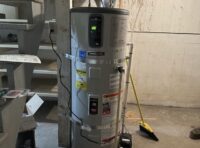
I was talking the other day with my buddy who lives northern Wisconsin on the topic heat pump water heaters (HPWHs). You see, he is in the market for a water heater and was asking my advice on those particular units. Wanting to know more myself, I pulled up some info and the more in-depth I got, the more I wanted to know. Cold weather performance, special ducting, size of mechanical space, accessibility to air, cooling and conditioning of adjacent space are all very important topics of discussion.
But, wait a minute, I thought to myself, I can use some of my “superpowers” as an editor in the trades these past 20+ years to ask people who are more in the know about HPWH than me.
I recently reached out to few people I trust to give me honest assessments of these units.
Advantage Heat Pump Water Heaters
According to Eric Aune, Aune Plumbing, Heating & Drains, there has been a ton of marketing to the public, and even more incentives for installation. “Local utilities are offering rebates upwards of $2-3K in some places, and here in Minnesota, we aren’t seeing rebates that high but it’s clear why the rebates are offered—because its lowering and spreading the load on the grid over longer periods at lower consumption rates. The utilities are trying to stay in front of or (most likely) catch up to the growing demand and stress on the grids all across the country. HPWH’s are one piece to the puzzle.”
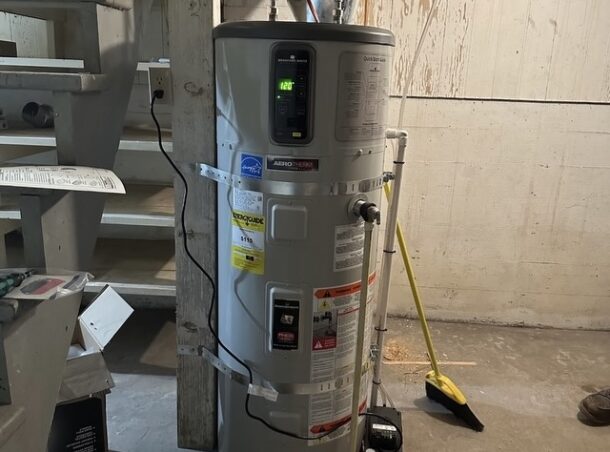
John Siegenthaler, P.E., Appropriate Designs, gives three bona fide advantages for HPWHs: One, they are excellent for capturing “surplus heat” (e.g., heat that’s present but not generated by another heat source for the purpose of warming the space). For example, solar heat gain to a garage, or heat generated by computer servers. Two, when properly applied, they can generate a given amount of DHW on about 1/3 the electrical input required by a standard “resistance type” electric water heater (tank or tankless). And three, some models are available that can operate on 120 VAC power, whereas all electric resistance water heaters require 240 VAC power.
But in Cold Climates?
But are these units considered more inefficient the more you climb the northern latitudes to colder climates? “Although heat pump water heaters are often placed in unconditioned spaces such as garages in southern locations, it would be a big mistake to do so in a cold northern climate where outside temperatures are below the minimum operating air temperature for the HPWH for weeks or months during winter,” says Siegenthaler. “The heating performance of any air source heat pump—ductless, central, air-to-water, HPWH, always decreases with decreasing air temperature—Putting any water heater in a cold space is not recommended. Standby heat loss would definitely increase.”
HPWHs have minimum air flow requirements, especially if placed in confined spaces, adds Siegenthaler. The I/O manual supplied with the unit should give all these requirements. “Some units allow ducting of outside air to the heat pump assembly on top of the tank, but I would only use this option in a relatively warm climate. Using ducted outside air also foregoes the cooling and dehumidifying benefit of the HPWH,” says Siegenthaler.
Living in Minnesota, Aune says, “HPWH’s capture/transfer the heat in the space surrounding them to the tank of water. When you talk about this here in Minnesota, it’s common for people to consider this inefficient since the we have to heat with a boiler or furnace, so aren’t we running our space heating system to provide heat for the water heater?
“The reality is the HPWH is able to capture and transfer a lot of energy without major negative effects on the conditioning and comfort of the space with a few considerations like ducting the less humid, colder air to the exterior of the house or even moving it with the furnace or exhaust fans,” says Aune.
According to Gary Klein, principal, Gary Klein and Associates, the majority of HPWHs sold today are hybrid HPWHs, and their efficiency is rated at 67.5 F and 50% relative humidity. “Very close to the temperature we keep the inside of conditioned buildings,” says Klein.
Klein suggests an interesting concept by managing the cold discharge air. “Install the HPWH in the basement near the space conditioning system. Use the return of that system to suck in the cold discharge air from the HPWH and distribute it throughout the house. Use a relay to link the fan to the HPWH. Let the thermostat decide if the air needs to be conditioned. Install a very large filter grille to bring air to the room where the HPWH is installed. (2-inch pleated filters).
“Need the ability to move at least 60 cfm per 100 watts of compressor, fan and control power. Warmer intake air increases the coefficient of performance (COP),” says Klein.
Siegenthaler points out that he did a column earlier this year that discussed a situation where a modern house used an air source heat pump for space heating, and combined it with a HPWH inside the house for DHW. Technically this puts the two heat pumps into a “cascade” relationship, says Siegenthaler.
“Think of the space heating heat pump as ‘feeding’ heat to the HPWH. It’s possible to show that the overall efficiency of this arrangement is lower than using a single air-to-water heat pump for both space heating and domestic hot water (DHW). I think that this is important because many builders, architects, energy planners, energy auditors, etc. don’t necessarily understand this concept. They assume that two heat pumps—one for space heating, and the other for DHW—are better than one.”
Siegenthaler stresses that the “ideal” scenario for a HPWH is to put it in a space where there’s “surplus heat.” “Don’t rob Peter to pay Paul,” says Siegenthaler.
There are plenty of such spaces, suggests Siegenthaler, especially in commercial buildings—manufacturing, heat from vending equipment or refrigeration equipment, cooking, laundry, computers, solar gain, attics that remain above 35ºF year-round, even mechanical rooms with lots of uninsulated piping, boilers, electrical transformers, greenhouses, cannabis grow houses, etc.
“Paraphrasing Patrick Henry, ‘Give me air, or give me death,'” says Klein.

The Caleffi Green was introduced to North America at the recently held AHR Expo in Chicago. The global initative defines a path forward with a multi-faceted plan of action for sustainability. An executive leadership team from the company’s Italian headquarters attended AHR to launch the initiative. Federica Beretta, Brand and Content Marketing Manager from Caleffi S.p.A Read more
The Caleffi Green was introduced to North America at the recently held AHR Expo in Chicago. The global initative defines a path forward with a multi-faceted plan of action for sustainability.
An executive leadership team from the company’s Italian headquarters attended AHR to launch the initiative. Federica Beretta, Brand and Content Marketing Manager from Caleffi S.p.A. stated, “We have launched a project called The Caleffi Green and we have been spreading it out all over the world. Sustainability is not only about processes and products, it is also about people. Every action is important.”
Caleffi’s global commitment to sustainability and resiliency is not new. Manufacturing is accomplished in an energy conscious manner, while prioritizing a healthy work environment for employees. For example, air pollutant emissions during the brass forging process are maintained 33% below the maximum particulate matter regulations in effect in Italy. More specifics can be found in the recently published Caleffi Group Sustainability Report.
As a reflection of Caleffi’s dedication to reducing its carbon footprint, a North America facility expansion will incorporate photovoltaic panels set to provide over 80% of the building’s electricity demands. In addition, over 90% of the building’s materials and labor will be regionally sourced.
Additionally, the North American group will expand the Caleffi Cares program to include a Volunteer Time Off (VTO) policy. Each member of the team has enormous potential to make an impact in their community. Milwaukee-based and remote employees have paid time to volunteer with the charities and organizations that make a positive impact in their families and communities. At the end of the year, Caleffi will hold a company-wide Lunch and Learn where employees can report on how they spent their time and share success stories.
Count on Caleffi to continue to support the industry with non-proprietary educational resources in our commitment to Excellence in Education. To design, install and service the best-case, energy efficient and water conscious systems there is no room for gaps in stakeholder training. It is in the collaboration of ideas and technologies from design to installation. We are committed to help all stakeholders achieve these lofty goals with resources such as the semi-annual idronics™ journal and Coffee with Caleffi™ webinar series.

Uponor North America (Uponor) announced Anna Picchetti as the new Vice President of Marketing & Strategy, effective May 8, 2023. In her role, Anna will oversee Channel Marketing, Portfolio, Analytics, Sustainability, Segment, Engagement, Brand, and Communications. She will report to Uponor North America President Andres Caballero and be a key member of the company’s Senior Management Committee. Anna joins Read more
Uponor North America (Uponor) announced Anna Picchetti as the new Vice President of Marketing & Strategy, effective May 8, 2023. In her role, Anna will oversee Channel Marketing, Portfolio, Analytics, Sustainability, Segment, Engagement, Brand, and Communications. She will report to Uponor North America President Andres Caballero and be a key member of the company’s Senior Management Committee.

Anna joins Uponor with 20 years of experience in Marketing and Operations across industrial, technology, and medical device industries. She brings a wealth of experience developing forward-thinking strategies with a strong track record of execution at industry-leading brands such as Tennant, SPS Commerce, and Honeywell. She has worked at the forefront of innovations like autonomous vehicles and renewable energy, managed high-growth SaaS products and positioning, and transformed customer experiences.
“To help us move our business and aggressive growth goals forward, it was important we found a senior leader who can lead market disruption and drive innovation and segment growth initiatives all while guiding channel development, portfolio management, and go-to-market strategies,” says Caballero. “I’m confident Anna’s approachable leadership style will be a good cultural fit, as she has a proven track record of engaging teams by intentionally listening, learning, and setting clear expectations and outcomes.”
Anna earned a Master of Business Administration degree from the Carlson School of Management at the University of Minnesota. She is a member of the Women United Committee for the Greater Twin Cities United Way chapter and is also a member of Chief, a network for women in the C-Suite as well as senior executives and vice presidents. In addition, she is a USA Hockey-certified coach with a local youth hockey program.
For information about Uponor products, systems, services, and solutions, visit uponor.com.

Consistently through the years, Plumbing Manufacturers International has fulfilled its vision of “safe, responsible plumbing – always.” But now, “we recognize we’re at a time when our social contract is being extended into areas such as climate change mitigation and diversity, equity and inclusion,” PMI CEO/Executive Director Kerry Stackpole states. “A Plumbing Manufacturing Evolution,” the PMI Read more
Consistently through the years, Plumbing Manufacturers International has fulfilled its vision of “safe, responsible plumbing – always.” But now, “we recognize we’re at a time when our social contract is being extended into areas such as climate change mitigation and diversity, equity and inclusion,” PMI CEO/Executive Director Kerry Stackpole states.
“A Plumbing Manufacturing Evolution,” the PMI 2022 Annual Report, explores how PMI member companies are responding to new societal demands while remaining profitable and meeting the needs of customers.
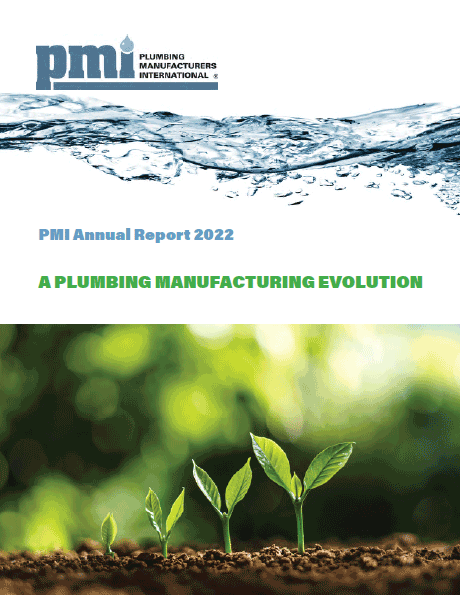
Running through the report are examples of how PMI member companies are striving to become “net positive” by improving the well-being of everyone they affect – every product, operation and stakeholder, including future generations and the planet itself. The term “net positive” was coined by co-authors Paul Polman and Andrew Winston in their book, “Net Positive: How Courageous Companies Thrive by Giving More Than They Take.”
In their letter for the report, PMI leaders Martin Knieps, 2022 Board of Directors president, and Todd Teter, immediate past president, say that even before the term “net positive” was coined, “PMI has worked to find solutions benefiting all water system stakeholders. PMI has always understood that the value of a toilet, showerhead or faucet is only as high as the quality of the water conveyed by it. As a result, PMI has always worked with the health and safety of water consumers in mind, knowing that their best interests are the same as ours.”
Report focuses on sustainability, supply chain and workplace
The report’s three main stories cover how PMI member companies are creating opportunities through their responses to challenges relating to sustainability and waste reduction, supply chain, and workplace and labor. Read the entire report at https://www.safeplumbing.org/communications/pmi-annual-report-2022.

San Antonio — The seventh Emerging Water Technology Symposium returned as an in-person event for the first time in four years, bringing together industry, manufacturing, water utility and government leaders from around the world. A focus of this year’s event was on resources communities require to build safe and resilient plumbing systems as well as Read more
San Antonio — The seventh Emerging Water Technology Symposium returned as an in-person event for the first time in four years, bringing together industry, manufacturing, water utility and government leaders from around the world. A focus of this year’s event was on resources communities require to build safe and resilient plumbing systems as well as meet the growing list of challenges to America’s drinking water.
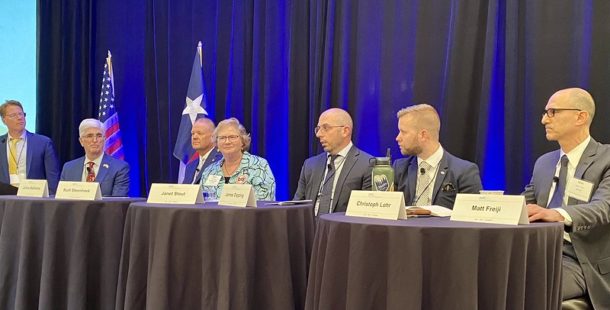
The esteemed panel on Effective Risk Management of Building Water Systems for Pathogen Control included (from l to r) Julius Ballanco, president, JB Engineering; Kurt Steenhoek, International Representative, UA; Janet Stout, Executive VP and Founder, Special Pathogen Laboratory; James Dipping, Director of Plumbing Engineering, Environmental Systems Design, Inc.; Christoph Lohr, VP of Strategic Initiatives, IAPMO; and Matt Freije, CEO, HC Info.
The May 10-11 event at the Westin Riverwalk, San Antonio was co-convened by the Alliance for Water Efficiency (AWE), the American Society of Plumbing Engineers (ASPE), the International Association of Plumbing and Mechanical Officials (IAPMO) and Plumbing Manufacturers International (PMI).
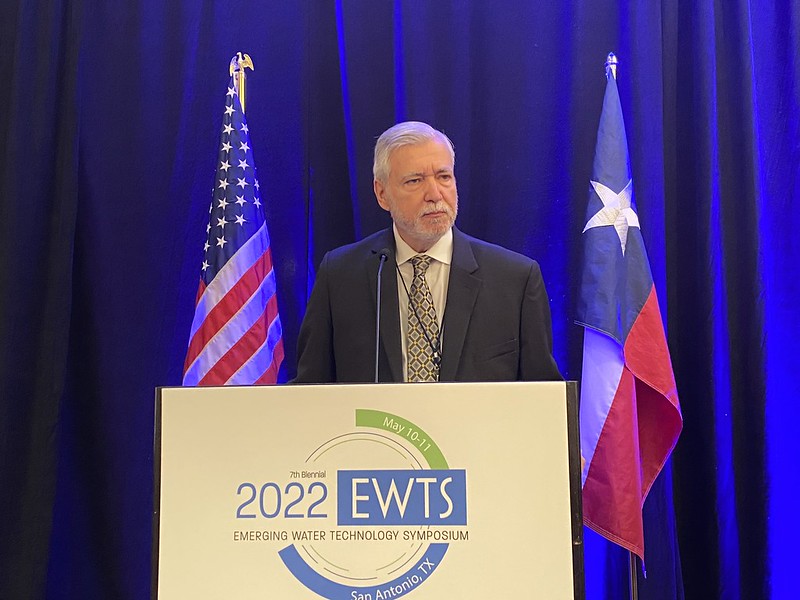
Pete DeMarco
“As an industry we have a number of high priority research needs that relate to water quality as well as water and energy efficiency,” IAPMO Executive Vice President of Advocacy and Research Pete DeMarco explained in discussing the importance of the symposium. “This year’s event brought together some of the brightest minds industry has to offer all focused on how we make our plumbing and mechanical systems safer and more resilient to meet the challenges ahead.”
In his opening remarks, DeMarco pointed to a number of accomplishments for which the EWTS has served as a springboard, including the development of the Green Plumbing and Mechanical Code Supplement (now the Water Efficiency and Sanitation Standard WE•Stand); ANSI/ASHRAE Standard 188-2018, Legionellosis: Risk Management for Building Water Systems; ASSE 12000 series on infection control and water quality, which is in IAPMO’s Uniform Plumbing Code (UPC®); and IAPMO’s Water Demand Calculator, whose second version was released in 2020.
“This symposium provides a much-needed platform for stakeholders across the industry to gather, discuss the latest research, and then discuss how we can take action,” he said. “It is a highly valuable event, and I look forward to seeing it continue to grow in the future.”
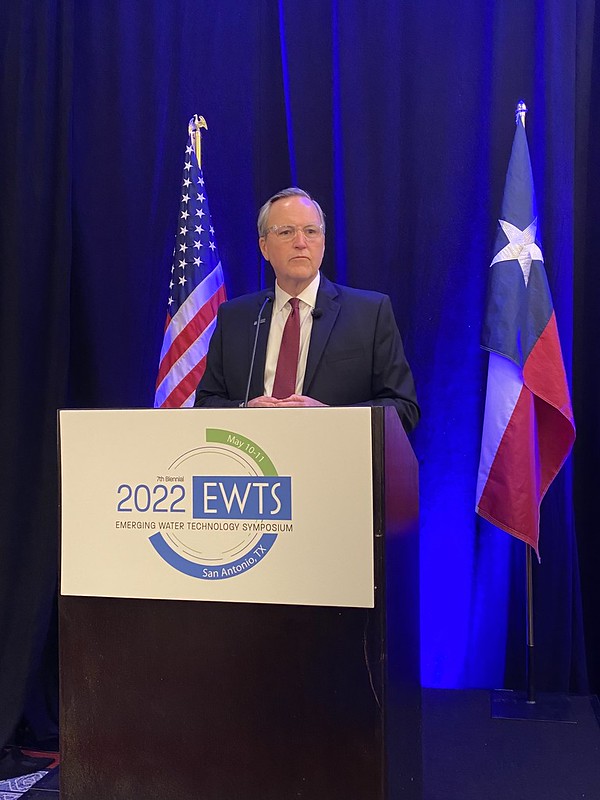
Kerry Stackpole
PMI CEO Kerry Stackpole spoke at the event and said the relationships between the organizations represented at EWTS had likely never been more important than they are now. He said that while the best and brightest among us devised medical solutions to the COVID-19 pandemic, the plumbing industry also played an important role.
“What’s also important is how our industry responded,” he said. “Our industry’s experience and our focus became touchless faucets, antimicrobial surfaces, water purification systems, all kinds of energy-efficient devices focused on safe and responsible plumbing. We all had a contribution to make and I think our industry stepped up.”
Stackpole said wildfires, flooding and drought that different regions of the United States are experiencing put those in the industry in a position to shape the future.
“Your active engagement here, in your communities back home, and in the marketplace of ideas, where we will have opportunities to share ideas with one another, will make all the difference,” he said. “You actually are able to turn the dial on this, and I think that’s really exciting.”
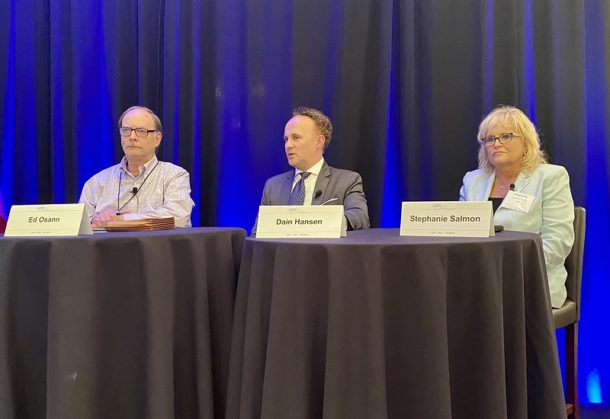
A day 2 panel saw (from l to r) Ed Osann, Senior Water Policy Analyst, NRDC; Dain Hansen, Executive Vice President, Government Relations, IAPMO; and Stephanie Salmon, Washington Representative, PMI, talk about the implications of the Infrastructure Investment and Jobs Act on Drinking Water and Wastewater.
This year’s keynote speakers were Robert Puente, president and CEO of the San Antonio Water System (SAWS), and Don Johnston, senior operations director, Indonesia, for Water.org.
Puente’s presentation looked at three ways in which SAWS, which serves 2 million customers over four counties, uses innovation to deliver water to its customers: advanced metering deployment, “smart” manhole covers, and conservation.
“It’s all about innovation,” he said. “And I think if you talk to our employees, although they will tell you that it’s their idea, we know that they got their idea from coming to events like this. Every good idea, you should expect it to be stolen, to be used by someone else, and you should be flattered by that. I think anything that you look at here started somewhere else, and we went to conferences in other cities and were able to bring back the ideas to SAWS to really get the innovation aspect in this.”
In delivering his keynote address remotely from Jakarta, Indonesia, Johnston spoke about the global water and sanitation crisis’s impact on low-income households — one in nine people lack access to safe water, one in three do not have access to a toilet — and some potential solutions. Working with financial institutions and water utilities, as well as sister company WaterEquity, Water.org helps bring affordable financing to people in need of water.
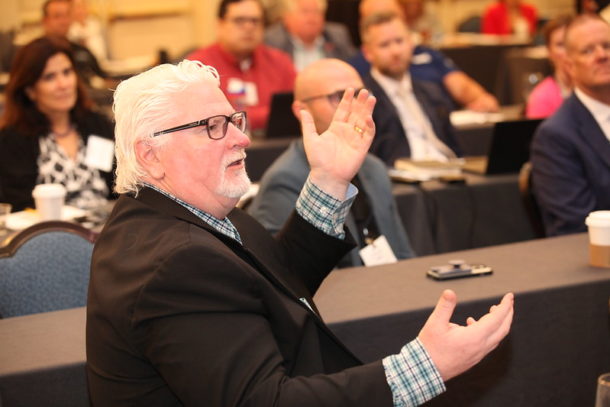
The Hub’s John Mesenbrink asks the hard-hitting questions during the symposium.
“In about 19 years of work on the ground, we’ve seen water and sanitation access reach more than 45 million people through more 10 million microloans disbursed to households with capital of $3.7 billion mobilized,” he said.
In his presentation, Phillip White, manager of plumbing and mechanical inspections for the city of Vancouver, British Columbia, shared how his city addressed the problem of insufficient sewer capacity when it came to capturing large amounts of rainfall through water reuse technologies. One development, the Oakridge Centre, utilized the IAPMO Water Demand Calculator and is expected to have the largest non-potable water system in North America.
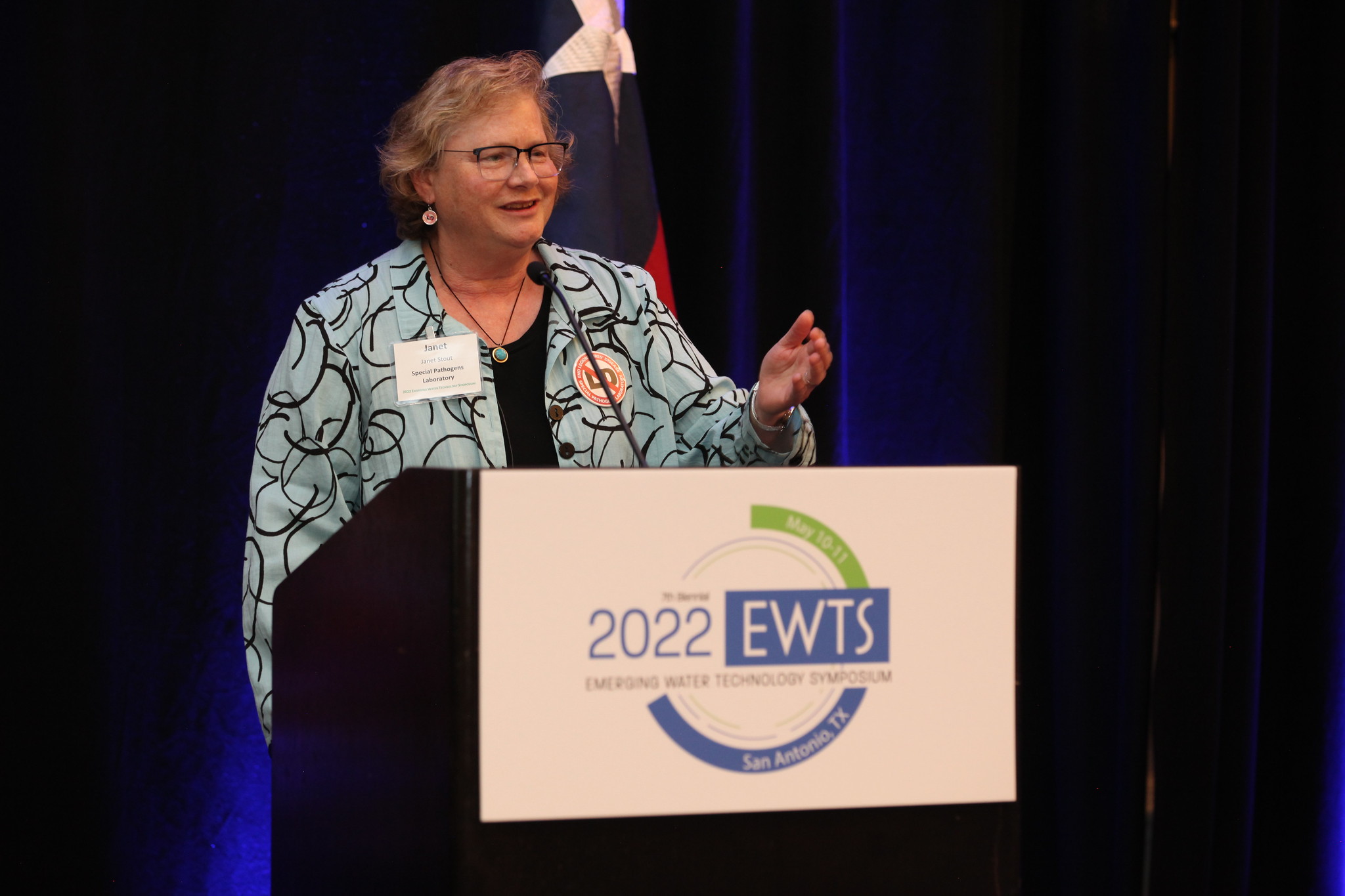
Janet Stout
Another speaker, Special Pathogens Laboratory Executive Vice President/Founder Dr. Janet Stout, looked at approaches and products for mitigating the risk of Legionellosis in point-of-use and point-of-entry building water systems. Improved water management requires knowledgeable Legionella prevention and water service providers, which can come from certification to ASSE/IAPMO/ANSI 12080 for Legionella Water Safety and Management Personnel.
IAPMO will provide sessions from the EWTS on-demand in the near future. To be notified when they are available, register at www.ewts.org/2022-ewts.
